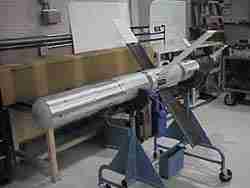The EFOG missile is one of the most revolutionary weapons in ground combat, and is explained at this website. Video guidance also allows precision air strikes against moving targets from 50,000 feet above with Fiber Optic Guided (FOG) bombs. The ground-launched EFOGM requires a rocket to propel the warhead out to 15km, which requires 50,000 feet of fiber. A free fall FOG bomb does not need a rocket since gravity will propel it when dropped.
Today's precision-guided munitions have drawbacks:
-GPS guidance is simple to jam, requires the targeting coordinates in advance, and cannot hit moving targets.
-GPS satellites may be destroyed.
-Sensor guidance munitions are expensive, can be fooled with decoys, and require the target to move or generate noise or heat.
-Laser-guided munitions are expensive and require good weather. In addition, an aircraft must fly low and expose itself to ground fire to locate and designate the target with a laser.
 A FOG bomb
has none of these disadvantages. An aircraft can drop a FOG
bomb from a safe, high-altitude as it approaches the target area. As the bomb
falls, it spools out miles of thin fiber optic wire like a fishing line, which provides a hard link back to a video display. The
bombardier sits at a station similar to the EFOGM (left) and literally
crashes the bomb into the target. Tests may reveal that bombs fall too
rapidly to allow the bombardier time to recognize some
targets. In that case, petals or a small "ballute" parachute can be used to slow the bomb's
descent, just like those used on bombs dropped by aircraft during low-level
attacks.
A FOG bomb
has none of these disadvantages. An aircraft can drop a FOG
bomb from a safe, high-altitude as it approaches the target area. As the bomb
falls, it spools out miles of thin fiber optic wire like a fishing line, which provides a hard link back to a video display. The
bombardier sits at a station similar to the EFOGM (left) and literally
crashes the bomb into the target. Tests may reveal that bombs fall too
rapidly to allow the bombardier time to recognize some
targets. In that case, petals or a small "ballute" parachute can be used to slow the bomb's
descent, just like those used on bombs dropped by aircraft during low-level
attacks.
 FOG bombs can be dropped from two-seat
attack aircraft or large bombers, which may have bombardiers at separate
stations onboard. Most likely, an aircraft will make numerous attack runs high over the
target area until its bomb load is depleted. Infrared cameras on the
bombs allow FOG bombs
to be dropped at night or in poor weather. Since bombardiers can
actually see the target just prior to impact, they can miss if it turns out to be civilian or friendly, and maybe disarm it prior to
impact. This allows aircraft to safely provide close air support to ground troops from
40,000 feet and
even hit moving tanks. Bombardiers will learn about
the target area with each bomb dropped, so each pass provides close reconnaissance
while bombardiers learn to distinguish decoys and identify nearby targets for the
next run.
FOG bombs can be dropped from two-seat
attack aircraft or large bombers, which may have bombardiers at separate
stations onboard. Most likely, an aircraft will make numerous attack runs high over the
target area until its bomb load is depleted. Infrared cameras on the
bombs allow FOG bombs
to be dropped at night or in poor weather. Since bombardiers can
actually see the target just prior to impact, they can miss if it turns out to be civilian or friendly, and maybe disarm it prior to
impact. This allows aircraft to safely provide close air support to ground troops from
40,000 feet and
even hit moving tanks. Bombardiers will learn about
the target area with each bomb dropped, so each pass provides close reconnaissance
while bombardiers learn to distinguish decoys and identify nearby targets for the
next run.
A FOG bomb is much simpler than a FOG missile (above) since it doesn't need a motor. It can use the fin control system already developed for the inexpensive JDAM GPS bombs. However, it does not require GPS target coordinates or a GPS signal and a FOG bomb is unjammable. This technology has already been developed, it just needs to be adapted to aircraft. It may be cheaper to build a system that uses thin wire, like TOW missile systems, since weight is not a issue with a falling bomb, unlike a missile flying horizontally. Training is simple since operators can hone skills in simulators. The FOG bomb is an ultimate airpower weapon.
©2015 www.G2mil.com